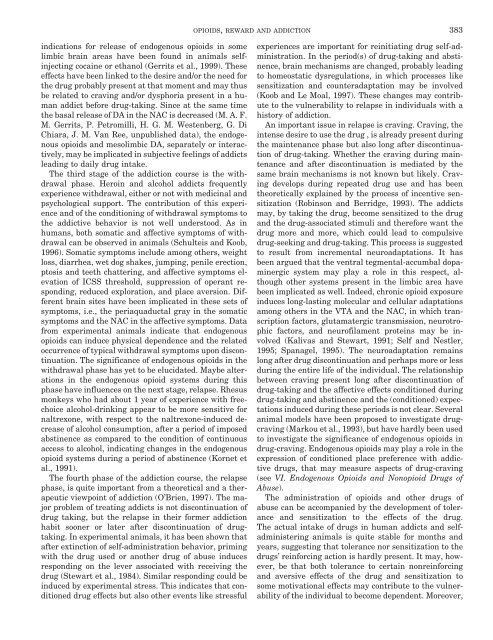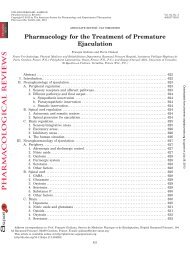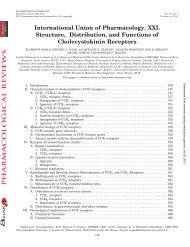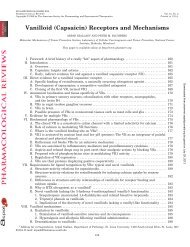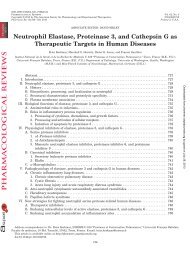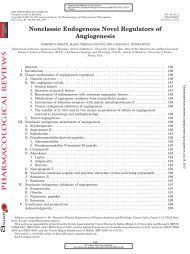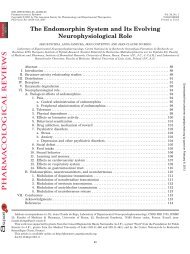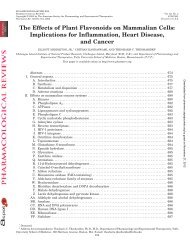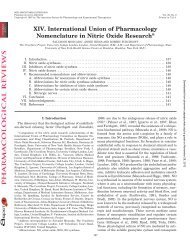Opioids, Reward and Addiction: An Encounter of Biology ...
Opioids, Reward and Addiction: An Encounter of Biology ...
Opioids, Reward and Addiction: An Encounter of Biology ...
You also want an ePaper? Increase the reach of your titles
YUMPU automatically turns print PDFs into web optimized ePapers that Google loves.
indications for release <strong>of</strong> endogenous opioids in some<br />
limbic brain areas have been found in animals selfinjecting<br />
cocaine or ethanol (Gerrits et al., 1999). These<br />
effects have been linked to the desire <strong>and</strong>/or the need for<br />
the drug probably present at that moment <strong>and</strong> may thus<br />
be related to craving <strong>and</strong>/or dysphoria present in a human<br />
addict before drug-taking. Since at the same time<br />
the basal release <strong>of</strong> DA in the NAC is decreased (M. A. F.<br />
M. Gerrits, P. Petromilli, H. G. M. Westenberg, G. Di<br />
Chiara, J. M. Van Ree, unpublished data), the endogenous<br />
opioids <strong>and</strong> mesolimbic DA, separately or interactively,<br />
may be implicated in subjective feelings <strong>of</strong> addicts<br />
leading to daily drug intake.<br />
The third stage <strong>of</strong> the addiction course is the withdrawal<br />
phase. Heroin <strong>and</strong> alcohol addicts frequently<br />
experience withdrawal, either or not with medicinal <strong>and</strong><br />
psychological support. The contribution <strong>of</strong> this experience<br />
<strong>and</strong> <strong>of</strong> the conditioning <strong>of</strong> withdrawal symptoms to<br />
the addictive behavior is not well understood. As in<br />
humans, both somatic <strong>and</strong> affective symptoms <strong>of</strong> withdrawal<br />
can be observed in animals (Schulteis <strong>and</strong> Koob,<br />
1996). Somatic symptoms include among others, weight<br />
loss, diarrhea, wet dog shakes, jumping, penile erection,<br />
ptosis <strong>and</strong> teeth chattering, <strong>and</strong> affective symptoms elevation<br />
<strong>of</strong> ICSS threshold, suppression <strong>of</strong> operant responding,<br />
reduced exploration, <strong>and</strong> place aversion. Different<br />
brain sites have been implicated in these sets <strong>of</strong><br />
symptoms, i.e., the periaquaductal gray in the somatic<br />
symptoms <strong>and</strong> the NAC in the affective symptoms. Data<br />
from experimental animals indicate that endogenous<br />
opioids can induce physical dependence <strong>and</strong> the related<br />
occurrence <strong>of</strong> typical withdrawal symptoms upon discontinuation.<br />
The significance <strong>of</strong> endogenous opioids in the<br />
withdrawal phase has yet to be elucidated. Maybe alterations<br />
in the endogenous opioid systems during this<br />
phase have influences on the next stage, relapse. Rhesus<br />
monkeys who had about 1 year <strong>of</strong> experience with freechoice<br />
alcohol-drinking appear to be more sensitive for<br />
naltrexone, with respect to the naltrexone-induced decrease<br />
<strong>of</strong> alcohol consumption, after a period <strong>of</strong> imposed<br />
abstinence as compared to the condition <strong>of</strong> continuous<br />
access to alcohol, indicating changes in the endogenous<br />
opioid systems during a period <strong>of</strong> abstinence (Kornet et<br />
al., 1991).<br />
The fourth phase <strong>of</strong> the addiction course, the relapse<br />
phase, is quite important from a theoretical <strong>and</strong> a therapeutic<br />
viewpoint <strong>of</strong> addiction (O’Brien, 1997). The major<br />
problem <strong>of</strong> treating addicts is not discontinuation <strong>of</strong><br />
drug taking, but the relapse in their former addiction<br />
habit sooner or later after discontinuation <strong>of</strong> drugtaking.<br />
In experimental animals, it has been shown that<br />
after extinction <strong>of</strong> self-administration behavior, priming<br />
with the drug used or another drug <strong>of</strong> abuse induces<br />
responding on the lever associated with receiving the<br />
drug (Stewart et al., 1984). Similar responding could be<br />
induced by experimental stress. This indicates that conditioned<br />
drug effects but also other events like stressful<br />
OPIOIDS, REWARD AND ADDICTION 383<br />
experiences are important for reinitiating drug self-administration.<br />
In the period(s) <strong>of</strong> drug-taking <strong>and</strong> abstinence,<br />
brain mechanisms are changed, probably leading<br />
to homeostatic dysregulations, in which processes like<br />
sensitization <strong>and</strong> counteradaptation may be involved<br />
(Koob <strong>and</strong> Le Moal, 1997). These changes may contribute<br />
to the vulnerability to relapse in individuals with a<br />
history <strong>of</strong> addiction.<br />
<strong>An</strong> important issue in relapse is craving. Craving, the<br />
intense desire to use the drug , is already present during<br />
the maintenance phase but also long after discontinuation<br />
<strong>of</strong> drug-taking. Whether the craving during maintenance<br />
<strong>and</strong> after discontinuation is mediated by the<br />
same brain mechanisms is not known but likely. Craving<br />
develops during repeated drug use <strong>and</strong> has been<br />
theoretically explained by the process <strong>of</strong> incentive sensitization<br />
(Robinson <strong>and</strong> Berridge, 1993). The addicts<br />
may, by taking the drug, become sensitized to the drug<br />
<strong>and</strong> the drug-associated stimuli <strong>and</strong> therefore want the<br />
drug more <strong>and</strong> more, which could lead to compulsive<br />
drug-seeking <strong>and</strong> drug-taking. This process is suggested<br />
to result from incremental neuroadaptations. It has<br />
been argued that the ventral tegmental-accumbal dopaminergic<br />
system may play a role in this respect, although<br />
other systems present in the limbic area have<br />
been implicated as well. Indeed, chronic opioid exposure<br />
induces long-lasting molecular <strong>and</strong> cellular adaptations<br />
among others in the VTA <strong>and</strong> the NAC, in which transcription<br />
factors, glutamatergic transmission, neurotrophic<br />
factors, <strong>and</strong> neur<strong>of</strong>ilament proteins may be involved<br />
(Kalivas <strong>and</strong> Stewart, 1991; Self <strong>and</strong> Nestler,<br />
1995; Spanagel, 1995). The neuroadaptation remains<br />
long after drug discontinuation <strong>and</strong> perhaps more or less<br />
during the entire life <strong>of</strong> the individual. The relationship<br />
between craving present long after discontinuation <strong>of</strong><br />
drug-taking <strong>and</strong> the affective effects conditioned during<br />
drug-taking <strong>and</strong> abstinence <strong>and</strong> the (conditioned) expectations<br />
induced during these periods is not clear. Several<br />
animal models have been proposed to investigate drugcraving<br />
(Markou et al., 1993), but have hardly been used<br />
to investigate the significance <strong>of</strong> endogenous opioids in<br />
drug-craving. Endogenous opioids may play a role in the<br />
expression <strong>of</strong> conditioned place preference with addictive<br />
drugs, that may measure aspects <strong>of</strong> drug-craving<br />
(see VI. Endogenous <strong>Opioids</strong> <strong>and</strong> Nonopioid Drugs <strong>of</strong><br />
Abuse).<br />
The administration <strong>of</strong> opioids <strong>and</strong> other drugs <strong>of</strong><br />
abuse can be accompanied by the development <strong>of</strong> tolerance<br />
<strong>and</strong> sensitization to the effects <strong>of</strong> the drug.<br />
The actual intake <strong>of</strong> drugs in human addicts <strong>and</strong> selfadministering<br />
animals is quite stable for months <strong>and</strong><br />
years, suggesting that tolerance nor sensitization to the<br />
drugs’ reinforcing action is hardly present. It may, however,<br />
be that both tolerance to certain nonreinforcing<br />
<strong>and</strong> aversive effects <strong>of</strong> the drug <strong>and</strong> sensitization to<br />
some motivational effects may contribute to the vulnerability<br />
<strong>of</strong> the individual to become dependent. Moreover,


